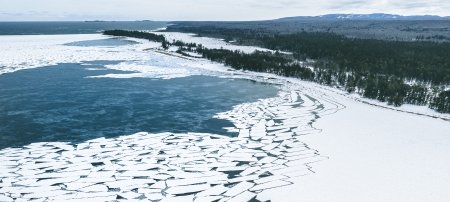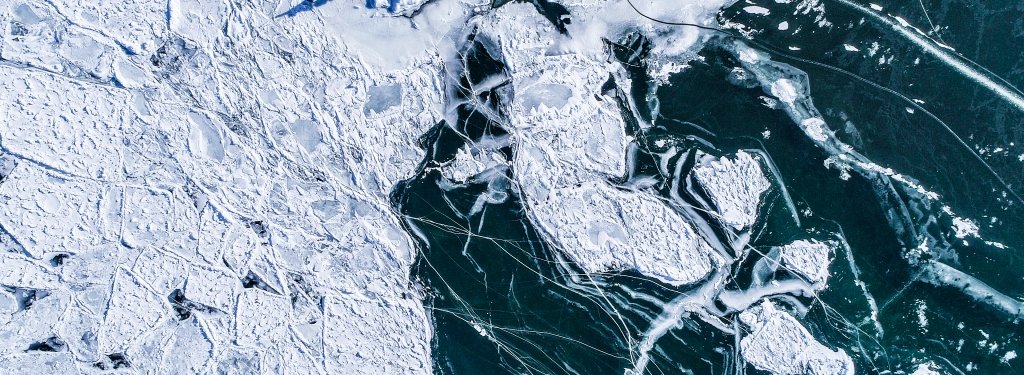$1.45 Million Study to Address the Northbound Flow of Airborne Toxics
Half of the people in Greenland have toxic levels of PCBs in their blood. A harmful cocktail of contaminants, including mercury and dioxin, has led to fish consumption advisories in all of the Great Lakes, including Superior.
Pollutants like these find their way north via a complex web of human and natural systems. Now, a team led by Michigan Technological University’s Judith Perlinger is working on a three-year project to better understand how those systems interact and find ways to address the problem.
The study partners include MIT, the Desert Research Institute and Boston University, as well as Michigan Tech. Funded by a $1.45 million grant from the National Science Foundation, they are focusing on three types of pollutants that have something in common: they leapfrog to their ultimate destination, hitching rides on atmospheric currents, landing back on Earth, and becoming airborne again, eventually concentrating in the north. The group will be studying mercury, polychlorinated biphenyl compounds (PCBs) and polycyclic aromatic hydrocarbons (PAHs). Together, they are known as atmosphere-surface exchangeable pollutants, or ASEPs.
“There are thousands of ASEPs, and they get all over the Earth, even in places where they have never been used or produced,” said Perlinger, a professor of civil and environmental engineering. “They stay in the environment for a long time, they tend to accumulate in people and wildlife, and as a result they can be very toxic, even though they are present at low concentrations in the environment.”
There’s a disconnect between where ASEPs are made and used and where they end up, which makes their regulation challenging. They originate in the Northern Hemisphere at lower latitudes, but they migrate to higher latitudes, thus the concern with the Great Lakes and the Arctic. “They accumulate in the fatty tissue of fish and seafood, which people consume, so populations that rely on fish in their diet get a high load of these chemicals,” said Perlinger. “The chemicals have a variety of toxic effects, and they pass through mothers’ milk to offspring, so that offspring get a high load at a young age, when their organ systems are still developing.”
The team members are undertaking a three-pronged research effort. First, they will estimate where the pollutants originate, describe the natural systems that transport them north, and identify where the pollutants finally land. Their models will offer predictions through the year 2050 and will account for the affects of climate change and changes in land use and cover and government policy relating to ASEPs.
Secondly, they will model the economic impacts of the pollutants throughout the US, focusing especially on the Northeast and Great Lakes. They will examine specific human health effects and associated economic consequences of consuming mercury-contaminated fish. Finally, they will identify the many stakeholders in the Great Lakes, from community and sportsman’s groups to government agencies and tribes, and propose strategies for them to work together to help address the problem.
“Oftentimes, what drives change is when people see there are monetary consequences,” Perlinger said. “The effects of eating mercury-contaminated fish are manifold with significant public health consequences, sometimes intergenerational, and they can play out over decades.” Demonstrating the long-term costs of mercury pollution could motivate changes in governance related to mercury and other ASEPs.
The project also has an educational component. The team is teaching a web-based course this spring called Communicating Wicked Environmental Problems. “’Wicked’ has a special meaning,” Perlinger said. “It refers to very complex problems that have a high degree of scientific uncertainty, can be very contentious, and lack a set of solutions that will not be harmful or disadvantageous to someone in some relevant way.”
In addition to Perlinger, scientists collaborating on the project are Noel Urban of Michigan Tech’s Department of Civil and Environmental Engineering; Shiliang Wu, who has dual appointments in Michigan Tech’s Departments of Geological and Mining Engineering and Sciences/Civil and Environmental Engineering; Emma Norman of Michigan Tech’s Department of Social Sciences and Great Lakes Research Center; Hugh Gorman, Michigan Tech’s Department of Social Sciences; Joan Chadde-Schumaker, Michigan Tech’s Department of Cognitive and Learning Sciences and the Western UP Center for Science, Mathematics, and Environmental Education; Noelle Eckley Selin of the Massachusetts Institute of Technology’s Engineering Systems Division and Department of Earth, Atmospheric and Planetary Sciences; Daniel Obrist of the Desert Research Institute’s Division of Atmospheric Sciences; Henrik Selin of International Relations at Boston University; and Juanita Urban-Rich, University of Massachusetts-Boston, Department of Environmental, Earth and Ocean Sciences.
Michigan Technological University is an R1 public research university founded in 1885 in Houghton, and is home to nearly 7,500 students from more than 60 countries around the world. Consistently ranked among the best universities in the country for return on investment, Michigan's flagship technological university offers more than 120 undergraduate and graduate degree programs in science and technology, engineering, computing, forestry, business, health professions, humanities, mathematics, social sciences, and the arts. The rural campus is situated just miles from Lake Superior in Michigan's Upper Peninsula, offering year-round opportunities for outdoor adventure.




Comments